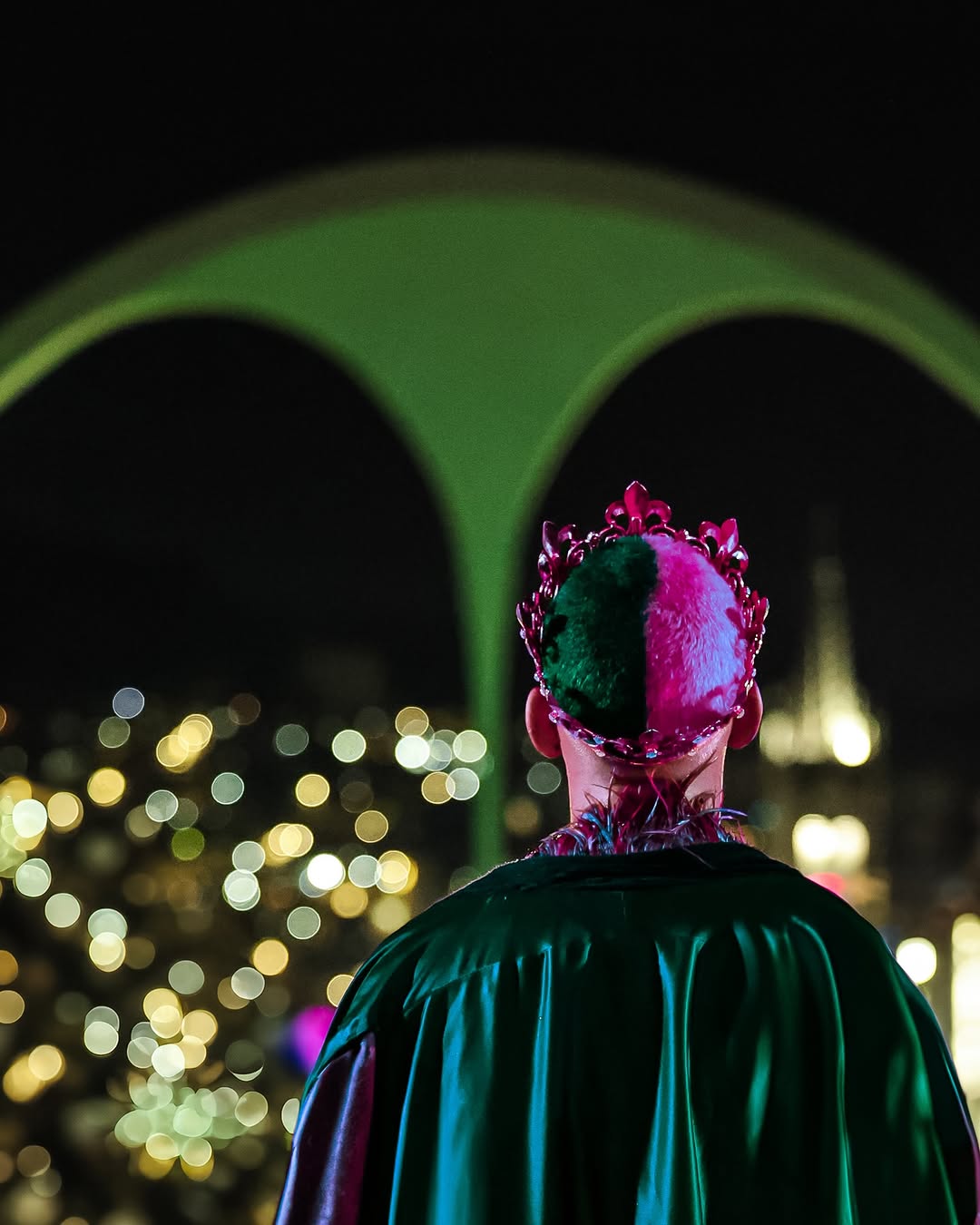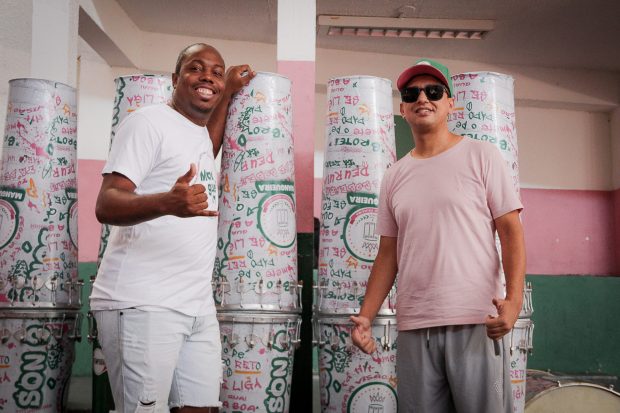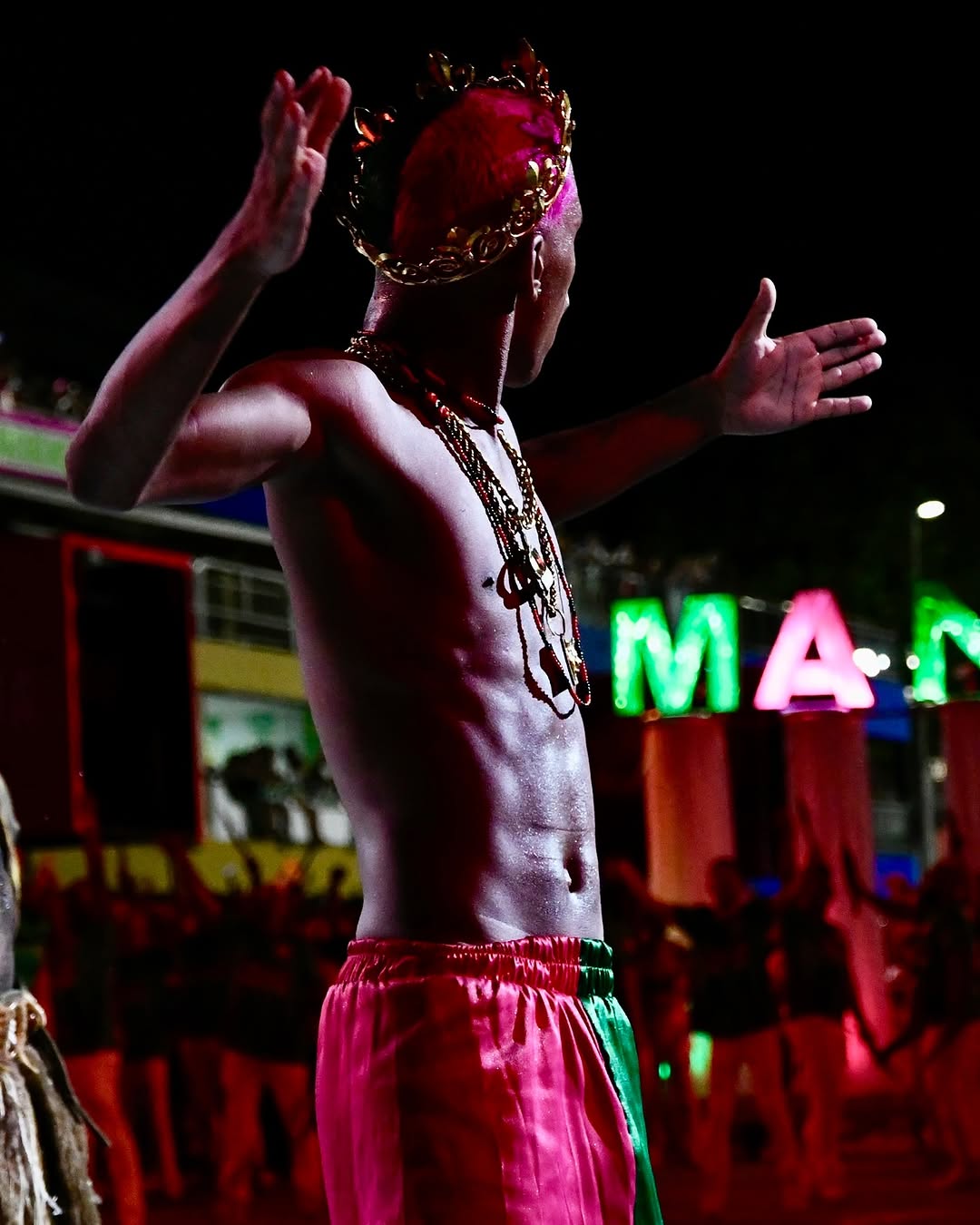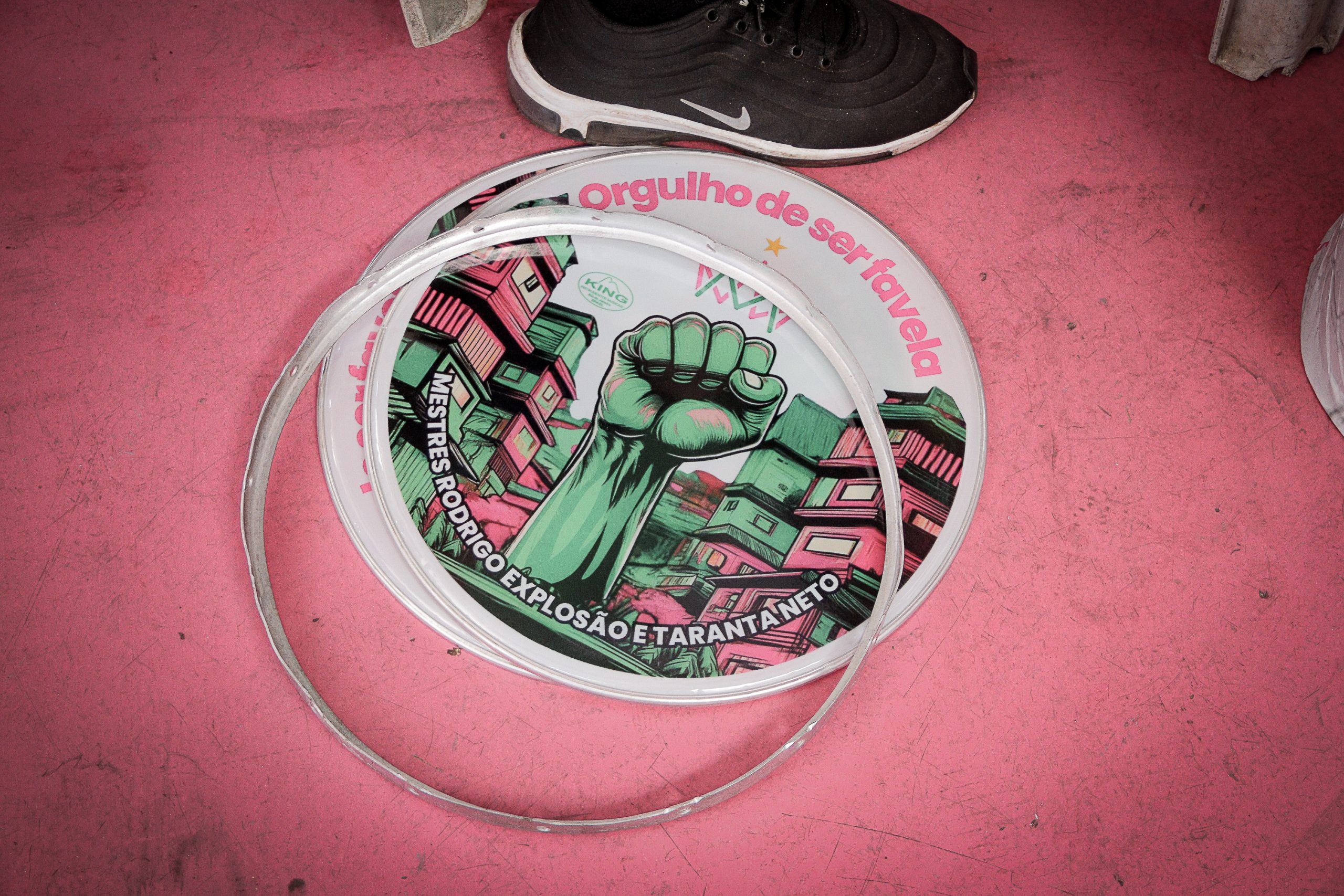
Rio de Janeiro’s 2025 Carnival is here, celebrating a people increasingly proud of themselves and their history. Of the 12 samba schools in the Special Group, only two—Mocidade and Vila Isabel—will not bring Afro-Indigenous themes to Rio’s famous Marquês de Sapucaí Sambadrome, which recently completed 40 years. The other ten will shine a spotlight on the spirituality of African, Afro-Brazilian, Indigenous and forest peoples, Afro-Indigenous cultures, Black Brazilian history, Afro-Brazilian trans identities, itans [mythological narratives of the Yoruba culture], mythical stories of the Yoruba orishas, and legendary figures of carnival who remain deeply present in the terreiros [sacred sites of Afro-Brazilian religious worship] and samba school workshops.
However, only one samba school places the favelas and those born and raised there at the heart of the world’s biggest party. Only one school crowns a shirtless cria sporting Kenner flip-flops, a gold chain around his neck, and dancing passinho with his hair creatively shaved with a cria design, bleached and dyed green and pink in the school’s colors: Mangueira Samba School (Estação Primeira da Mangueira). Cria is a term, growing quickly in usage in Brazil in recent years, depicting the pride of those who can claim to have been both born and raised in a particular favela.

By telling the story of the Bantu peoples of central and southern Africa and how their knowledge and beliefs shaped Brazil, all the way through the country’s present-day favelas, Mangueira’s theme elicits historical reparations. Its samba song composed for the 2025 parade describes how the kamutuê—the head, the dwelling place of the sacred for the Bantu peoples, where one’s personal Nkisi resides—guides all Black people from Mangueira, one of Rio’s oldest favelas, and the broader diaspora, towards self-knowledge.
View this post on Instagram
Effectively a matriarch of Brazilian samba, the Mangueira Samba School’s parade, on Sunday March 2, will present the history of the Bantu peoples from Congo, Angola, and Mozambique: their religions, their abduction and forced arrival at Rio’s Valongo Wharf, their multiple forms of resistance, and their contribution to the diverse Afro-Brazilian religious practices of Rio, such as the city’s macumbas, as well the worship of Nkisis, deities from the Congo-Angolan religious tradition of Candomblé. All these elements will demonstrate how this history continues to shape the Mangueira community to this day. In 2025, Mangueira will, thus, parade the epistemology of its cria while undertaking historical reparations and envisioning Bantu-favela-based Afro-futures.
To better understand how Mangueira intends to “take the city by storm,” as is declared in another part of its 2025 samba song, RioOnWatch interviewed Hudson de Oliveira Brito, better known as Taranta Neto, one of the masters of the “Respect my tamborim” rhythm section [“Tem que respeitar meu tamborim“], current Gold Banner winner [Estandarte de Ouro], and grandson of Taranta, a historic rhythm section master of the school. We also spoke with Sidnei França, a debuting carnival designer in Rio, but already an established name in São Paulo’s carnival scene. We met for our chat before the street rehearsal, which takes place every Thursday and Sunday until the week before carnival on Rua Visconde de Niterói, at the foot of Morro da Mangueira. On this particular day, after the rehearsal, a funk dance party was also set to take place in the green-and-pink favela.
Despite a busy day, Taranta Neto and Sidnei França spoke at length with RioOnWatch in the rhythm section’s directors’ room, sharing their perspectives on Carnival 2025. We discussed the theme “À Flor da Terra: O Rio da Negritude Entre Dores e Paixões” (“In Full Bloom: Rio’s Blackness Between Pain and Passion”) and their expectations for the parade.
RioOnWatch: For starters, I’d like to ask you both to please introduce yourselves.

And that’s it, we’re in the fight to bring Mangueira the championship—that’s what matters most to us, no matter what. I think that for those of us in the favela, and even for Mangueira fans outside, the most important thing is winning the title and making the community happy.
Sidnei França: Well, I’m Sidnei França, Mangueira’s carnival designer. This is my first year here, invited by [Mangueira Samba School] President Guanayra Firmino. It’s my debut in Rio’s carnival—not just in Mangueira, but in the entire Rio carnival scene. My whole journey has been in São Paulo’s carnival, where all my samba traditions come from, since I was born there. My mom was a lead samba dancer at a samba school called Mocidade Alegre. She got pregnant at 16—very young, right? She took me to the samba school from an early age, so I’ve basically been in this world since birth. I wasn’t even old enough to parade, then I went on to the children’s section.
In São Paulo, I come from a tradition of youth departments. Since we don’t have children’s samba schools there, what we do have are youth departments within the schools, where you get involved in all segments to understand what resonates with you. From there, they guide you toward the children’s section, the Youth Master of Ceremonies and Female Flag Bearer role, or the rhythm section. It’s a rite of passage, so to speak.
And, like I said, this is my first year at Mangueira, invited by President Guanayra Firmino. A year ago, during Rio’s Champions’ Parade, she called me over and said, “Come to Rio. I’m inviting you to be my school’s carnival designer.” From then on, the rest is history.


RioOnWatch: Master Taranta Neto, we’d love for you to share how you and Rodrigo Explosão came up with the idea of creating the rhythm section’s warm-up based on two iconic Rio funk tracks. How do you see these funk songs connecting with the samba school’s theme?
Taranta Neto: Actually, it wasn’t an idea we came up with from scratch. While studying the theme for the mini-parade, we knew we had to do something different, and what could be more fitting than representing exactly what the theme calls for? In this case, the funk track Rap da Felicidade [The Happiness Rap]: “All I want is to be happy, to walk freely in the favela where I was born.” I think the theme speaks directly to this: the history of Black people. A people who have suffered, but who, in the midst of pain and struggle, had their passions: coming together, celebrating, and having fun. That’s who we are today!
You know, I had never really heard about the Bantu people before, and bringing this theme to life was a brilliant move by Sidnei. When he first proposed it, I don’t think anyone fully grasped what it really meant. But after a meeting up on the third floor, where he came in and broke it all down for us, I think everyone walked out of there in awe.
So, it’s only right that we represent who we are, our daily lives. This is our history, our culture. That’s it.
But basically, the funk idea wasn’t something we came up with. We just needed to put something together for the mini-parade. We added these funk tracks to the rhythm section, and the rest was already there. It’s like we always say: “It’s always been there—we just had to find it.”
RioOnWatch: And since we’re talking about the theme, Sidnei, can you tell us how you came to the decision to work with this topic?
Sidnei França: President Guanayra hired me as Mangueira’s carnival designer, and from day one, she made it very clear that the school didn’t have a theme yet—there was no story set to be told and she expected me to come up with one. She said, “Look, it’s up to you. Of course, we need to approve it, and the theme has to connect with the school, but you have the freedom to propose something.”
And I was happy because it’s pretty great that a carnival designer gets to be the author of the story being told. So I started reading a lot. I already wanted something that truly reflected Mangueira and Rio de Janeiro—something with identity, something the Mangueira community could connect with. That’s when I came across a book called À Flor da Terra [a play on words that means both “Just Under Earth’s Surface” and “In Full Bloom”], which delves into the history of the New Blacks.
Who were the New Blacks? The New Blacks were enslaved Africans who arrived through the Valongo Wharf and were still within their first 30 days in Brazil. In other words, they had only recently set foot in Rio. After 30 days, they were no longer considered “New Blacks”—they were already part of the house, so to speak.
This is actually incredible: here we are today, talking about the cria from Morro da Mangueira. But back then, white colonizers didn’t just categorize Black people as New Blacks—they also classified them by age. Children were called new kids, and depending on their age [newborns, for instance], they were referred to as cria.
This book really spoke to me because it said that 80% of the Black people who arrived in Rio de Janeiro were Bantu. Man, if 80% were Bantu, then where did everything they brought from Africa go? Why does no one talk about it?
I think the greatest achievement of Mangueira’s theme is precisely this: bringing authorship and respect to a group of Black people that has never been acknowledged. For example, everyone talks about Orixás, but no one talks about Nkisi (Inquice, in its Brazilian spelling and usage). They talk about the Nagô and the Yoruba, but they don’t talk about the Bantu.
Samba, for example, is a Bantu word. Quilombo is Bantu. Quitanda [small grocer] is Bantu. Quitute, dengo, xodó, chamego—all of these [everyday Brazilian words] come from Bantu. So, basically, we spend the entire day speaking and understanding life through Bantu words, but most people have no idea what they mean or who the Bantu people are, past and present. And that, too, is an injustice to this people and their memory.
The idea behind À Flor da Terra is to show that Mangueira has the authority—like few other schools do—to talk about Rio, Black identity, the cria, the hillsides, the favelas, the community, respect, and ancestrality. No other school could [as authoritatively] unravel this yarn, could present this story to society. That’s what we’ve been striving to do. This theme was born out of the need to talk about Rio, including the Rio of today. The cria is today’s Rio, but always with the understanding that our present comes from the past.

RioOnWatch: Building on that, there is a central Bantu term in Mangueira’s 2025 theme, which is also present in the samba: the so-called “Casas de Zungu” [Zungu Houses]. What are they? And what is the connection between the “Casas de Zungu” and Mangueira Favela?
Sidnei França: Exactly. In fact, the favela of Mangueira itself is a great Casa de Zungu—and that’s another example of Bantu erasure. The Bantu created the Casas de Zungu in Rio de Janeiro’s old downtown. These were a kind of urban quilombo. The classic quilombos we usually think of were hidden deep in the forests, far away, where Black people fled to escape enslavement or mistreatment by their enslavers. Those quilombos were in remote areas. But within the city, there were the Casas de Zungu. And despite the name “house,” they weren’t just a single house but more like a small village. If you walked through downtown areas where we currently have Saúde, Gamboa, Santo Cristo, Praça Onze, Cidade Nova, and Estácio, you would find clusters of houses, alleys—something similar to a tenement. In these places, Black people would gather, form communities, and the police wouldn’t enter. So, the Casas de Zungu were places of protection.
In the Casas de Zungu, people practiced capoeira. In the Casas de Zungu, you got your spiritual initiation—you were initiated into Candomblé. In the Casas de Zungu, you found food. That’s why they were called “Zungu.” In the Kikongo language, the word comes from the combination of “nzu,” meaning “house,” and “ungu” or angu, a traditional African dish that remains popular to this day.
Casas de Zungu were truly cells of protection, places where you could be yourself. If out in the streets people criticized you for practicing the Afro-Brazilian religious rites of macumba or capoeira, inside the Casa de Zungu—a Black space—you had the freedom to be yourself. When the police came and tried to destroy a Casa de Zungu, another one would pop up two months later. Black people have always found a way through the cracks, a way to resist through alternative paths. That’s how it was from 1830 to 1910—almost 100 years of Casas de Zungu. Nowadays, children don’t learn about this. They don’t know what a Casa de Zungu is. Just look at how history is cruel to Blackness. You go to school to learn about Dom Pedro, to learn about the “discovery” of Brazil, but no one tells you about the Casas de Zungu. And this isn’t some made-up story—this is real history.
So [with this year’s carnival] what Mangueira is doing is reclaiming many aspects of Bantu culture that have been erased, that have been silenced. Mangueira is saying that every modern favela is a true Casa de Zungu. Of course, today the mechanisms are different—the way samba is made has changed, maybe capoeira isn’t practiced in the same way anymore. But there’s still funk, charme, passinho—other ways for the body to express itself. There are new tools engaging with modernity, but it’s still a great Casa de Zungu. Inside these spaces, you are, in a way, understood—while out there, they don’t understand who you are.
View this post on Instagram
RioOnWatch: Following this line of thought about the Casa de Zungu and its connection to Mangueira Hill, Master Taranta, tell us a bit about what you know of the history of the favela and your grandfather—his significance to you and to the rhythm section.
Taranta Neto: Sure! So, Mangueira Samba School was founded out of different street parades, or blocos. There was the Arengueiros bloco, Tia Fé’s bloco, a bunch of those. Mangueira’s original samba compound was actually in Buraco Quente, at Guanayra’s great-great-grandmother’s house—who is now the school’s president. It was during a meeting there that they decided to found Mangueira. Besides being the samba compound, that house was also a terreiro, a place for Afro-Brazilian worship. So, right from the start, that’s who we’ve been: resistance!
My granddad is my biggest idol. He was the one who taught me everything. It’s hard for me to talk about him because, honestly, I still can’t. Even though it’s been 10, 12 years since he passed, I still haven’t really been able to accept it. He always used to say that his dream was to see me become a master. But back then, that wasn’t my dream. I wanted to be a soccer player. Over time, he got me used to living in this rhythm section world. At first, I’d only come around every now and then. But through these Saturdays with him, I started falling in love with it. And from then on, I never wanted to leave.

I gave up soccer, and I’m still here today. Thank God, I’ve been able to carry on the legacy he left behind. It was something I promised him—that I would become what he always believed I was meant to be. Following in his footsteps, being a master, leaving my mark—whether for a year, three years, five, or ten, it’s about being here, doing good work, staying humble, and helping those who need help.
View this post on Instagram
RioOnWatch: Sidnei, about the technical rehearsal—the Front Commission was a big hit, especially with the character representing the Nganga, who transforms into the crowned cria. Can you tell us a bit about this idea?
Sidnei França: Just like the rhythm section mentioned by Hudson, everyone was looking for a unique touch to bring to the technical rehearsal. With that in mind, our choreographers, Carina and Lucas, came to the samba school workshop to talk with me and my team to see if there was a story—something powerful that might not stand out as much during the parade but could really shine through the Front Commission. That’s when we remembered the ngangas, a kind of healer whose great power is transformation. So it hit us: let’s turn him from a wise healer into a cria from the favela. And that’s how the idea came to life. And it was truly beautiful to choose Flavio Lopes, better known as Flavinho—a young guy from the community who dances passinho—to play the role of the young cria stepping into adulthood. It was a huge hit at the technical rehearsal, with Mangueira shining right from the Front Commission on, in that powerful scene of the nganga shedding his African cloak and revealing himself as a crowned cria from the Mangueira favela, dressed in green and pink and dancing passinho. It was a beautiful moment—truly, truly beautiful! And it was a collective achievement, from our theme research team, Stephanie and Tinoco, to our choreographers.
Ver essa foto no Instagram
RioOnWatch: Master, which part of the samba moves you the most?
Taranta Neto: Man, there are so many, but the one that really reflects our reality here—for me, personally, and in general—is the line: “o alvo que a bala insiste em achar” (the target the bullet insists on finding). That one really speaks to us, there’s no way around it. We’re used to waking up to gunfire here. Less so nowadays—Mangueira is much calmer now. But every now and then, there’s still a police operation that keeps us up, on alert, afraid for our family and friends who live in other parts of the favela. You know?
Ver essa foto no Instagram
This part of the samba is the one that hits the hardest. Not just for me—I believe for 100% of the school and the community as well.

RioOnWatch: Continuing with Mangueira’s 2025 theme, samba school rhythm sections include Bantu instruments, and with that in mind, the school chose to honor the cuíca in one of its floats. Sidnei, can you tell us a bit about this?
Sidnei França: I wouldn’t even call it a choice. Based on our research, the most widely spread Bantu instrument in Brazil—of course, adapted into modern musicality, instrumentation, and percussive style—is the cuíca. So there really couldn’t be any other instrument. In fact, when we arrived in the city of Lubango, in Angola, we visited the Anthropology Museum, and the guide started explaining, “Ah, here we have the puíta, which later became the cuíca.” I looked at it and thought, “Wow!”
So I’d say the cuíca chose the theme. The cuíca spoke: “If you’re going to talk about Bantu ancestrality, then know that I’m here. It’s not going to happen without me.” Personally, I get very emotional about having the cuíca take on a bigger role in the parade. Normally, the rhythm section provides the sound, but the visual part is just the costumes. But I think it’s beautiful when you bring the rhythm section’s narrative into a float and make it a central part of telling the story. It shows that the rhythm section isn’t just there to provide the soundtrack for the parade—it carries ancestrality. That’s why I know this is going to be a truly special moment in the parade, without a doubt.
RioOnWatch: To wrap up our conversation, what do you see as the legacy of Mangueira’s 2025 Carnival?
Sidnei França: Looking ahead, I don’t know what will happen in this parade, because we know there are many factors—there are nine judging criteria that all have to come together to win a title for the school. Of course, I want Mangueira to be champion, but more than that, I want this parade to leave a mark on the community.
For example, I look at José William [who plays the young cria in Mangueira’s 2025 parade]. He’s the son of Laura, who works in our supply department. They’re from the Mangueira favela and their whole family is part of the school. This theme also helps him understand who he is. For me, that alone is incredibly rewarding. It’s already a huge gift! I hope this goes down in Mangueira’s history as a legacy carnival—something truly remarkable for the school.

When I speak to the school, it’s not just to its leaders—I’m talking to all of us, as members, creators of samba: Mangueira is bigger than any of us. May the school pulse this carnival, not just for the result, but so that 100 years from now, someone remembers: “Hey, there was a carnival that spoke about the cria, about the community, about what it means to be favela, the pride of being favela, about being Bantu.”

In fact, I talk a lot about the future with Guanayra—we have long conversations, you know, those late-night talks? The kind where you stop talking about carnival and start talking about everything else. And something we were discussing the other day is that it’s beautiful to think about Mangueira’s past, but it’s just as important to envision what Mangueira will become moving forward. That’s why the aesthetic I’m trying to establish this carnival isn’t just that of a traditional school. Yes, it’s an old, traditional school, but it also has to look toward the future—with a more modern, laid-back visual style, without losing its tradition, its green and pink, its symbols.
Visually apeaking, Mangueira needs to connect with modern aesthetics—so that today’s children look at it, feel drawn to it, and want to carry this tradition into the future. Otherwise, they might start losing interest and say, “Man, Mangueira is cool, but I don’t think it’s for me. I think I want something else.” So what we need today is the awareness that our work is also shaping the Mangueira of Tomorrow, the future Mangueira.
Watch “Manifesto: Rio Is Bantu – Mangueira 2025” Here:
This interview has been edited and condensed for clarity.
About the author: Rhuan Gonçalves is a native of Macaé, a city in the north of Rio de Janeiro state. He holds a degree in History from the Pontifical Catholic University of Rio de Janeiro (PUC-Rio) and is director and producer of the documentary “Menino de 47 Vai a Campo”, about the founding of the professional football team of the Império Serrano Samba School. He is a photographer for the Imagens do Povo Collective, linked to the Favelas Observatory, located in the favelas of Maré, and a percussionist for samba schools Império Serrano, Estação Primeira de Mangueira and Acadêmicos de Vigário Geral.
